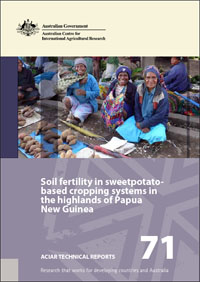- HomeHome
-
About ACIAR
- Our work
- Our people
-
Corporate information
- ACIAR Audit Committee
- Commission for International Agricultural Research
- Policy Advisory Council
- Agency reviews
- Executive remuneration disclosure
- Freedom of information (FOI)
- Gifts and benefits register
- Information publication scheme
- List of new agency files
- Contracts
- Legal services expenditure
- Privacy impact assessment register
- Commonwealth Child Safe Framework
- Benefits to Australia
- Careers
- 40 years of ACIAR
-
What we do
- Programs
- Cross-cutting areas
- Resources
- Where we work
-
Funding
- Research projects
- Fellowships
-
Scholarships
- John Allwright FellowshipScholarships to study in Australia for ACIAR partner country scientists to have Australian postgraduate qualifications
- ACIAR Pacific Agriculture Scholarships and Support and Climate Resilience Program
- Alumni Research Support Facility
- Publications
- News and Outreach
Image

Technical report
Soil fertility in sweetpotato-based cropping systems in the highlands of Papua New Guinea
Date released
27 July 2009
Publication Code
TR071
Overview
High population growth is a problem in most developing countries, and projections for many countries are that the increased demand for food will outstrip the capacity of the land to produce that food. Papua New Guinea (PNG) has high population growth, however the area under agricultural production has remained stable, and land use has intensified. There is a trend towards more continuous cropping systems that is linked to high population densities—as the population increases, the demand for food and cash crops increases. Thus, the need to identify promising management practices to expand both food and cash crops, while sustaining soil fertility, is becoming increasingly important for PNG. This report summarises the results from a pilot study on soil fertility management, and reviews sweetpotato-based cropping systems in the highlands of PNG. It also describes the lessons learnt from survey methodologies used to assess the socioeconomic and biophysical constraints to sweetpotato production in this area. Case studies from similar surveys done in Nigeria and northern New South Wales, Australia, are included as examples.


